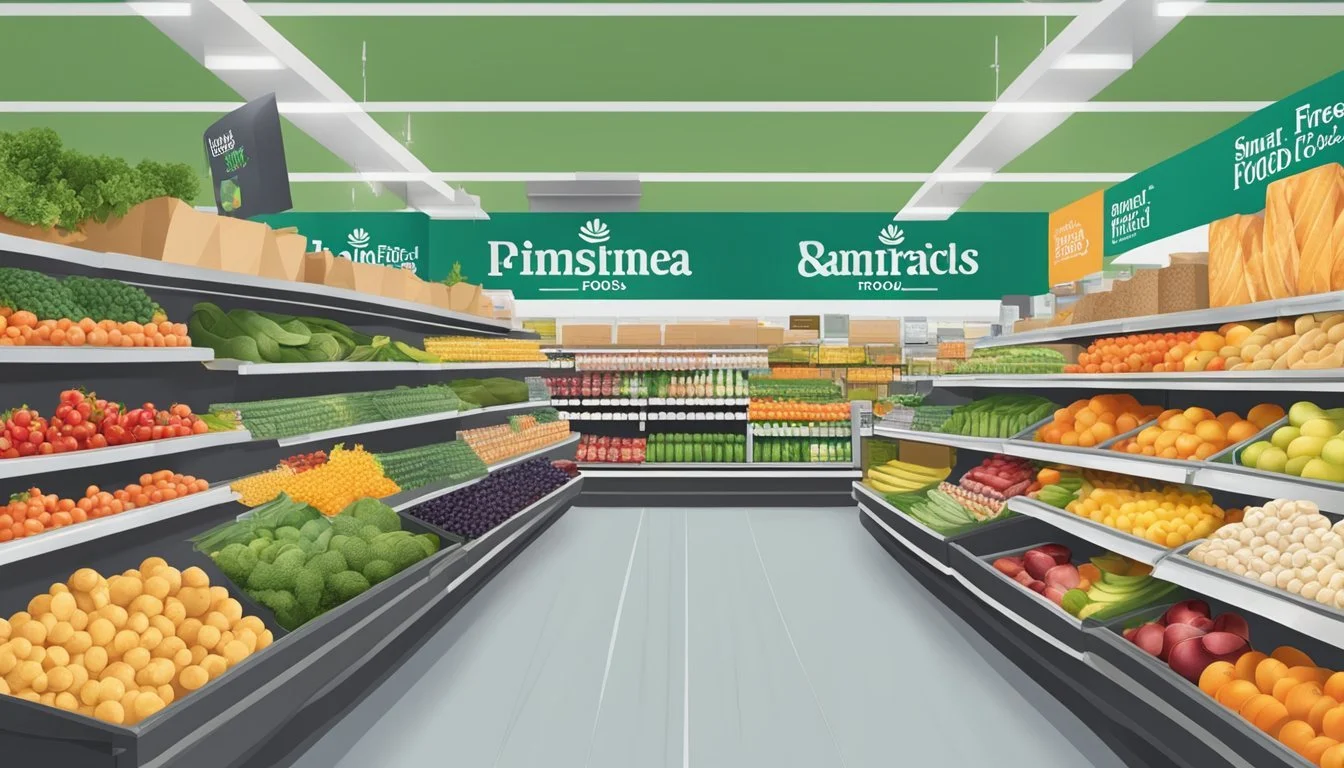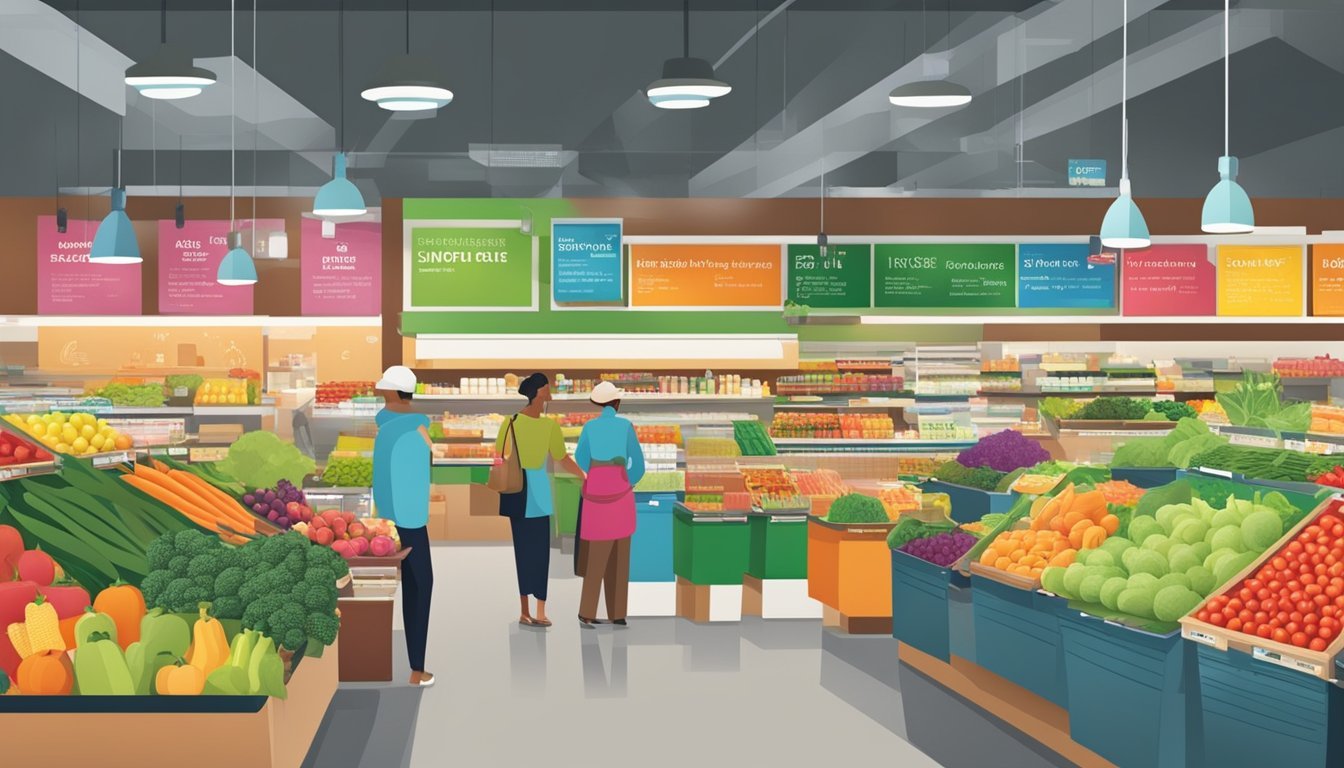Smart & Final vs Whole Foods
A Comprehensive Comparison of Price, Quality, and Selection
Smart & Final and Whole Foods represent two distinctly different approaches to grocery shopping. Smart & Final focuses on bulk purchases and low prices, catering to both households and small businesses. Whole Foods, on the other hand, emphasizes organic and high-quality products, often at premium prices.
Smart & Final offers significantly lower prices, with some items costing up to 22% less than average grocery stores. This makes it an attractive option for budget-conscious shoppers and those buying in large quantities. The store's no-frills approach and limited selection of brands contribute to its ability to keep prices down.
Whole Foods prioritizes organic, natural, and locally-sourced products. While more expensive, it appeals to health-conscious consumers and those willing to pay extra for perceived higher quality. The store's aesthetics, customer service, and range of prepared foods provide a more upscale shopping experience compared to Smart & Final's utilitarian environment.
Understanding the Grocery Landscape
The grocery industry encompasses a diverse array of store types catering to different consumer needs. From budget-friendly options to premium organic markets, shoppers have many choices for their food purchases.
Defining the Grocery Store
A grocery store is a retail establishment that primarily sells food and household items. These stores stock a wide range of products including fresh produce, meat, dairy, canned goods, and non-food essentials. Modern grocers often feature bakeries, delis, and prepared food sections.
Grocery stores vary in size and format. Smaller neighborhood markets may focus on everyday staples. Larger supermarkets offer extensive selections across many departments. Some specialize in natural or ethnic foods to serve niche markets.
Most grocers aim to be one-stop shops for families' weekly needs. They compete on factors like price, quality, convenience, and customer service.
Overview of Supermarket Chains
Major supermarket chains dominate the U.S. grocery landscape. Top players include Kroger, Albertsons, Publix, and Ahold Delhaize. These companies operate multiple store brands across different regions.
Walmart and Target have also become significant grocery retailers. Their supercenter formats combine general merchandise with full supermarkets under one roof.
Specialty chains like Whole Foods and Trader Joe's focus on natural and organic products. Discount grocers such as Aldi and Lidl emphasize low prices through limited selections and private labels.
Online grocery services from Amazon and Instacart are disrupting traditional models. Many established chains now offer their own e-commerce and delivery options.
Role of Grocery Stores in Family Shopping
Grocery stores play a central role in most families' routines. They serve as the primary source for essential food and household goods. Many shoppers visit their local supermarket multiple times per week.
Grocers aim to meet diverse needs across demographics. They stock products for various dietary preferences, family sizes, and budgets. Many offer additional services like pharmacies and financial services for convenience.
Store layouts and promotions are designed to influence purchasing decisions. End-cap displays, store circulars, and loyalty programs encourage impulse buys and repeat visits. Some chains focus on creating an enjoyable shopping experience through attractive decor and product sampling.
Key Players in the Market
The grocery landscape is dominated by several major retailers, each with unique offerings and market positioning. Smart & Final and Whole Foods represent contrasting approaches to serving customers.
Profile: Smart & Final
Smart & Final operates as a warehouse-style grocery chain without membership fees. The company targets both household shoppers and small businesses with bulk products and competitive pricing. Smart & Final stores typically feature a no-frills layout and focus on value.
Their product mix includes both name-brand and private label items. The chain offers fresh produce, meats, and household staples alongside restaurant-sized packaging options. Smart & Final's pricing strategy aims to be 10-15% lower than traditional supermarkets.
The company has a strong presence in the Western United States, particularly California. Smart & Final has expanded its footprint through acquisitions and new store openings in recent years.
Profile: Whole Foods Market
Whole Foods Market positions itself as a premium grocery retailer specializing in natural and organic products. The chain emphasizes high-quality, ethically sourced items and maintains strict standards for ingredients allowed in their stores.
Since its acquisition by Amazon in 2017, Whole Foods has integrated Prime member benefits and expanded its online ordering capabilities. The stores feature extensive produce sections, prepared foods, and specialty departments like cheese shops and bakeries.
Whole Foods' pricing has historically been higher than traditional supermarkets, earning the nickname "Whole Paycheck." However, the Amazon partnership has led to some price reductions and exclusive deals for Prime members.
Coverage of Other Notable Stores
Walmart remains the largest grocery retailer in the U.S., leveraging its massive scale to offer low prices. The company has invested heavily in online grocery services and store pickup options.
Kroger, the largest traditional supermarket chain, competes through a mix of store formats and strong private label offerings. Regional players like Publix in the Southeast and Wegmans in the Northeast maintain loyal customer bases through quality service and prepared foods.
Discount chains like Grocery Outlet and WinCo Foods attract price-conscious shoppers with deeply discounted products. Trader Joe's carves out a niche with unique private label items and a curated selection.
Price Analysis
Smart & Final and Whole Foods occupy different segments of the grocery market, with distinct pricing strategies and value propositions. Their approaches to pricing, deals, and overall costs significantly impact the shopping experience for consumers.
Comparing Costs Between Stores
Smart & Final generally offers lower prices compared to Whole Foods. A typical basket of groceries at Smart & Final costs 15-20% less than at Whole Foods. For example, staple items like milk, eggs, and bread are often priced 10-15% lower at Smart & Final.
Whole Foods' prices tend to be higher due to its focus on organic and premium products. However, since Amazon's acquisition, Whole Foods has made efforts to reduce prices on select items. Despite these reductions, it remains more expensive than Smart & Final for most comparable products.
Smart & Final's bulk options can lead to additional savings for customers willing to buy larger quantities. This pricing strategy appeals to families and small businesses looking to economize.
Understanding the Value Proposition
Whole Foods emphasizes quality, organic options, and ethically sourced products. This focus justifies their higher prices for many consumers who prioritize these attributes. The store offers a wide selection of specialty and gourmet items not typically found at Smart & Final.
Smart & Final positions itself as a value-oriented option, blending elements of a warehouse club with a traditional grocery store. It targets budget-conscious shoppers and small businesses with its no-membership-fee model and mix of bulk and individual items.
Product selection differs significantly between the two stores. Whole Foods carries a broader range of organic and natural products, while Smart & Final offers more conventional brands and larger package sizes.
Evaluating Deals and Discounts
Both stores employ different strategies for deals and discounts. Smart & Final regularly offers weekly specials and uses loss leaders to attract customers. These deals often focus on popular household items and pantry staples.
Whole Foods provides exclusive discounts for Amazon Prime members, including an additional 10% off sale items. The store also features rotating "Prime Member Deals" on select products throughout the store.
Smart & Final's loyalty program provides personalized offers and points that can be redeemed for discounts on future purchases. In contrast, Whole Foods relies more on its Prime member benefits for customer retention.
Both stores use mobile apps to deliver digital coupons and personalized offers to customers. However, Smart & Final tends to offer more frequent and widespread discounts compared to Whole Foods' more targeted approach.
Product Quality and Selection
Smart & Final and Whole Foods differ significantly in their product offerings and quality standards. Both stores aim to meet diverse customer needs but take distinct approaches to sourcing and selection.
Assessing the Quality of Produce
Smart & Final offers a mix of conventional and organic produce at competitive prices. Their fruits and vegetables are generally fresh, though the selection may be more limited compared to larger supermarkets. Whole Foods, on the other hand, is renowned for its high-quality produce section. They prioritize organic and locally-sourced options, often featuring unique or heirloom varieties. Whole Foods' strict quality standards ensure that their produce is free from artificial preservatives, colors, and flavors.
Diversity of Organic Options
Smart & Final carries a modest selection of organic products, primarily in their produce department. Their organic offerings have expanded in recent years but remain limited compared to specialty grocers. Whole Foods excels in this area, with a vast array of organic options across all departments. From fresh produce to pantry staples, Whole Foods provides certified organic alternatives for most conventional items. They also offer many exclusive organic brands and products not found in other stores.
Availability of Meat and Seafood
Smart & Final's meat and seafood departments focus on value and convenience. They offer pre-packaged meats and a selection of frozen seafood options. While the quality is generally good, the variety may be less extensive than specialized butcher shops. Whole Foods sets high standards for its meat and seafood. They source from farms and fisheries that meet strict animal welfare and sustainability criteria. Whole Foods offers a wide range of fresh, organic, and grass-fed meats, as well as sustainably caught or farmed seafood. Their butchers and fishmongers provide custom cuts and preparation services.
Brand and Product Availability
Smart & Final and Whole Foods offer distinct product ranges catering to different consumer preferences. Each store's inventory reflects its unique positioning in the grocery market.
Exploring Exclusive Brands
Smart & Final features its First Street private label, offering value-priced alternatives across various categories. This brand includes pantry staples, frozen foods, and household items. Whole Foods, on the other hand, promotes its 365 by Whole Foods Market line. This brand focuses on natural and organic products, aligning with the store's health-conscious image.
Both chains also carry exclusive partnerships with smaller, artisanal brands. Smart & Final collaborates with regional suppliers for fresh produce and specialty items. Whole Foods champions local and emerging brands through its Local Producer Loan Program.
Range of Generic Staples
Smart & Final excels in providing bulk quantities of generic staples at competitive prices. Their inventory includes large packages of rice, beans, flour, and other pantry essentials. This approach appeals to both households and small businesses seeking cost-effective options.
Whole Foods offers a more curated selection of generic staples. While their prices may be higher, they emphasize organic and non-GMO options. Consumers can find alternatives like almond flour, coconut sugar, and other health-focused variants of common ingredients.
Milk serves as a good comparison point. Smart & Final typically stocks conventional brands at lower prices, while Whole Foods carries organic and specialty milk options.
Specialty Items Accessibility
Whole Foods is renowned for its extensive array of specialty and gourmet items. The store caters to specific dietary needs with a wide selection of gluten-free, vegan, and paleo-friendly products. Their cheese and wine departments often feature artisanal and hard-to-find selections.
Smart & Final, while more limited in specialty offerings, has expanded its range to include trendy health foods and international ingredients. The store now stocks items like quinoa, chia seeds, and a variety of ethnic sauces and spices.
Both chains have responded to the growing demand for plant-based alternatives. Whole Foods typically offers a broader range of these products, including lesser-known brands. Smart & Final has incorporated popular plant-based options into its inventory, focusing on mainstream alternatives.
Shopping Experience
Smart & Final and Whole Foods offer distinct shopping environments tailored to different customer preferences. Their store layouts, customer service approaches, and digital offerings shape unique experiences for shoppers.
Store Layout and Convenience
Smart & Final stores are designed for efficiency, catering to both individual shoppers and small businesses. Aisles are wide, allowing for easy navigation with large carts. Bulk items and restaurant-sized packages are prominently displayed. The layout emphasizes quick shopping trips and value-oriented purchases.
Whole Foods markets feature a more upscale ambiance with a focus on natural and organic products. Stores often include specialty sections like cheese counters, bakeries, and prepared food bars. The layout encourages browsing and discovery, with attractive displays of fresh produce and gourmet items.
Both chains prioritize convenience, but in different ways. Smart & Final offers a straightforward shopping experience, while Whole Foods creates a more immersive environment.
Customer Service Ratings
Whole Foods is known for its knowledgeable staff and emphasis on customer satisfaction. Employees often receive extensive training on product information and dietary needs. This approach typically results in higher customer service ratings and a more personalized shopping experience.
Smart & Final focuses on efficient service and competitive pricing. While staff may not offer the same level of product expertise as Whole Foods, they are generally helpful and attentive to customer needs. The chain's emphasis on value and convenience often leads to positive customer feedback in these areas.
Both stores strive for customer satisfaction, but Whole Foods tends to receive higher ratings for personalized service and product knowledge.
Online Shopping and Delivery Services
Smart & Final and Whole Foods have both expanded their digital offerings to meet increasing demand for online grocery shopping and delivery. Whole Foods, backed by Amazon's technology, provides a seamless online shopping experience with same-day delivery options in many areas.
Smart & Final offers online ordering and delivery through its own platform and third-party services. While not as technologically advanced as Whole Foods, it provides a functional and user-friendly online shopping experience.
Both chains have invested in improving their digital presence, but Whole Foods generally offers more sophisticated online tools and faster delivery options. The choice between the two may depend on local availability and personal preferences for online shopping interfaces.
Consumer Considerations
When choosing between Smart & Final and Whole Foods, shoppers must weigh several key factors. These include health and dietary needs, environmental and ethical concerns, and budget constraints.
Health and Dietary Factors
Smart & Final offers a mix of conventional and health-focused products. Their selection includes some organic and natural options, but the range is more limited than Whole Foods.
Whole Foods prioritizes natural foods and bans artificial colors, flavors, and sweeteners. This appeals to health-conscious consumers seeking fewer processed ingredients.
For those with specific dietary needs, Whole Foods provides more extensive options for gluten-free, vegan, and other specialized diets. Their produce section often features a wider variety of organic fruits and vegetables.
Smart & Final carries some healthier alternatives but focuses more on bulk items and general groceries. This can make it challenging for shoppers with strict dietary requirements.
Environmental and Ethical Concerns
Whole Foods emphasizes sustainability and ethical sourcing. They work closely with local farmers and ranchers, promoting environmentally friendly practices.
The store's commitment to animal welfare standards and sustainable seafood sourcing appeals to ethically minded consumers. They also offer a wider range of eco-friendly household and skincare products.
Smart & Final's approach to environmental and ethical concerns is less prominent. While they do carry some sustainable products, it's not a primary focus of their business model.
Both stores have made efforts to reduce plastic waste, but Whole Foods generally offers more plastic-free alternatives and bulk shopping options.
Budget Constraints
Smart & Final typically offers lower prices on many items, especially when buying in bulk. This makes it attractive for budget-conscious shoppers or those stocking up for large families or events.
Their store brand, First Street, provides affordable alternatives to name-brand products. However, the quality may vary compared to premium or organic options.
Whole Foods has a reputation for higher prices, often dubbed "Whole Paycheck" by some consumers. Their focus on organic and premium products contributes to this perception.
To address budget concerns, Whole Foods offers the 365 Everyday Value brand as a more affordable option. They also provide weekly deals and discounts for Amazon Prime members.
Shoppers on a tight budget may find Smart & Final more accessible for everyday groceries. However, Whole Foods can be cost-effective for specific natural or organic products.
Market Insights and Trends
Grocery retailers are adapting to shifting consumer preferences and technological advancements. These changes impact product offerings, pricing strategies, and shopping experiences at stores like Smart & Final and Whole Foods.
Research and Consumer Trends
Researchers have identified a growing demand for organic and natural products. Whole Foods capitalizes on this trend with its wide selection of organic items. Smart & Final has expanded its organic offerings to compete. Both stores are increasing their selection of plant-based proteins and meat alternatives.
Consumer interest in locally sourced foods is rising. Whole Foods partners with local ranchers and farmers to stock regional products. Smart & Final has begun highlighting locally produced items in some stores.
Sustainability concerns influence purchasing decisions. Whole Foods has implemented eco-friendly packaging initiatives. Smart & Final is working to reduce plastic waste in its stores.
Adaptations to the Digital Era
Online grocery shopping has surged in popularity. Whole Foods leverages Amazon's technology for efficient delivery services. Smart & Final has partnered with Instacart to offer same-day delivery options.
Mobile apps enhance the in-store experience. Whole Foods' app provides digital coupons and product information. Smart & Final's app offers personalized deals and easy list-making features.
Self-checkout and contactless payment options are becoming standard. Both retailers have invested in these technologies to reduce wait times and improve convenience.
Voice-activated shopping through smart speakers is emerging. Whole Foods allows voice ordering through Alexa devices. Smart & Final is exploring similar capabilities to stay competitive in the digital landscape.







